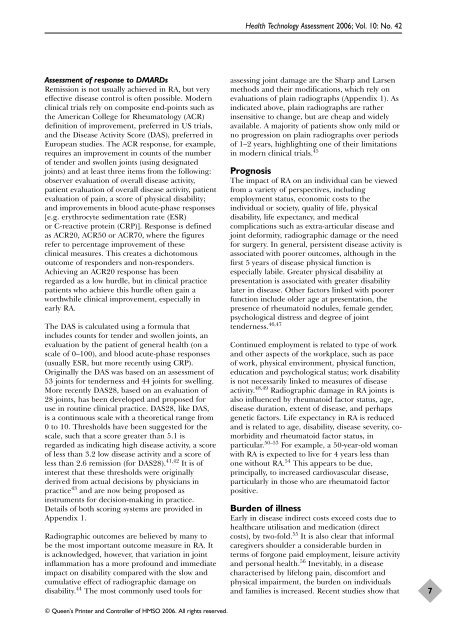A systematic review of the effectiveness of adalimumab
A systematic review of the effectiveness of adalimumab
A systematic review of the effectiveness of adalimumab
Create successful ePaper yourself
Turn your PDF publications into a flip-book with our unique Google optimized e-Paper software.
Assessment <strong>of</strong> response to DMARDs<br />
Remission is not usually achieved in RA, but very<br />
effective disease control is <strong>of</strong>ten possible. Modern<br />
clinical trials rely on composite end-points such as<br />
<strong>the</strong> American College for Rheumatology (ACR)<br />
definition <strong>of</strong> improvement, preferred in US trials,<br />
and <strong>the</strong> Disease Activity Score (DAS), preferred in<br />
European studies. The ACR response, for example,<br />
requires an improvement in counts <strong>of</strong> <strong>the</strong> number<br />
<strong>of</strong> tender and swollen joints (using designated<br />
joints) and at least three items from <strong>the</strong> following:<br />
observer evaluation <strong>of</strong> overall disease activity,<br />
patient evaluation <strong>of</strong> overall disease activity, patient<br />
evaluation <strong>of</strong> pain, a score <strong>of</strong> physical disability;<br />
and improvements in blood acute-phase responses<br />
[e.g. erythrocyte sedimentation rate (ESR)<br />
or C-reactive protein (CRP)]. Response is defined<br />
as ACR20, ACR50 or ACR70, where <strong>the</strong> figures<br />
refer to percentage improvement <strong>of</strong> <strong>the</strong>se<br />
clinical measures. This creates a dichotomous<br />
outcome <strong>of</strong> responders and non-responders.<br />
Achieving an ACR20 response has been<br />
regarded as a low hurdle, but in clinical practice<br />
patients who achieve this hurdle <strong>of</strong>ten gain a<br />
worthwhile clinical improvement, especially in<br />
early RA.<br />
The DAS is calculated using a formula that<br />
includes counts for tender and swollen joints, an<br />
evaluation by <strong>the</strong> patient <strong>of</strong> general health (on a<br />
scale <strong>of</strong> 0–100), and blood acute-phase responses<br />
(usually ESR, but more recently using CRP).<br />
Originally <strong>the</strong> DAS was based on an assessment <strong>of</strong><br />
53 joints for tenderness and 44 joints for swelling.<br />
More recently DAS28, based on an evaluation <strong>of</strong><br />
28 joints, has been developed and proposed for<br />
use in routine clinical practice. DAS28, like DAS,<br />
is a continuous scale with a <strong>the</strong>oretical range from<br />
0 to 10. Thresholds have been suggested for <strong>the</strong><br />
scale, such that a score greater than 5.1 is<br />
regarded as indicating high disease activity, a score<br />
<strong>of</strong> less than 3.2 low disease activity and a score <strong>of</strong><br />
less than 2.6 remission (for DAS28). 41,42 It is <strong>of</strong><br />
interest that <strong>the</strong>se thresholds were originally<br />
derived from actual decisions by physicians in<br />
practice 43 and are now being proposed as<br />
instruments for decision-making in practice.<br />
Details <strong>of</strong> both scoring systems are provided in<br />
Appendix 1.<br />
Radiographic outcomes are believed by many to<br />
be <strong>the</strong> most important outcome measure in RA. It<br />
is acknowledged, however, that variation in joint<br />
inflammation has a more pr<strong>of</strong>ound and immediate<br />
impact on disability compared with <strong>the</strong> slow and<br />
cumulative effect <strong>of</strong> radiographic damage on<br />
disability. 44 The most commonly used tools for<br />
© Queen’s Printer and Controller <strong>of</strong> HMSO 2006. All rights reserved.<br />
Health Technology Assessment 2006; Vol. 10: No. 42<br />
assessing joint damage are <strong>the</strong> Sharp and Larsen<br />
methods and <strong>the</strong>ir modifications, which rely on<br />
evaluations <strong>of</strong> plain radiographs (Appendix 1). As<br />
indicated above, plain radiographs are ra<strong>the</strong>r<br />
insensitive to change, but are cheap and widely<br />
available. A majority <strong>of</strong> patients show only mild or<br />
no progression on plain radiographs over periods<br />
<strong>of</strong> 1–2 years, highlighting one <strong>of</strong> <strong>the</strong>ir limitations<br />
in modern clinical trials. 45<br />
Prognosis<br />
The impact <strong>of</strong> RA on an individual can be viewed<br />
from a variety <strong>of</strong> perspectives, including<br />
employment status, economic costs to <strong>the</strong><br />
individual or society, quality <strong>of</strong> life, physical<br />
disability, life expectancy, and medical<br />
complications such as extra-articular disease and<br />
joint deformity, radiographic damage or <strong>the</strong> need<br />
for surgery. In general, persistent disease activity is<br />
associated with poorer outcomes, although in <strong>the</strong><br />
first 5 years <strong>of</strong> disease physical function is<br />
especially labile. Greater physical disability at<br />
presentation is associated with greater disability<br />
later in disease. O<strong>the</strong>r factors linked with poorer<br />
function include older age at presentation, <strong>the</strong><br />
presence <strong>of</strong> rheumatoid nodules, female gender,<br />
psychological distress and degree <strong>of</strong> joint<br />
tenderness. 46,47<br />
Continued employment is related to type <strong>of</strong> work<br />
and o<strong>the</strong>r aspects <strong>of</strong> <strong>the</strong> workplace, such as pace<br />
<strong>of</strong> work, physical environment, physical function,<br />
education and psychological status; work disability<br />
is not necessarily linked to measures <strong>of</strong> disease<br />
activity. 48,49 Radiographic damage in RA joints is<br />
also influenced by rheumatoid factor status, age,<br />
disease duration, extent <strong>of</strong> disease, and perhaps<br />
genetic factors. Life expectancy in RA is reduced<br />
and is related to age, disability, disease severity, comorbidity<br />
and rheumatoid factor status, in<br />
particular. 50–53 For example, a 50-year-old woman<br />
with RA is expected to live for 4 years less than<br />
one without RA. 54 This appears to be due,<br />
principally, to increased cardiovascular disease,<br />
particularly in those who are rheumatoid factor<br />
positive.<br />
Burden <strong>of</strong> illness<br />
Early in disease indirect costs exceed costs due to<br />
healthcare utilisation and medication (direct<br />
costs), by two-fold. 55 It is also clear that informal<br />
caregivers shoulder a considerable burden in<br />
terms <strong>of</strong> forgone paid employment, leisure activity<br />
and personal health. 56 Inevitably, in a disease<br />
characterised by lifelong pain, discomfort and<br />
physical impairment, <strong>the</strong> burden on individuals<br />
and families is increased. Recent studies show that<br />
7
















